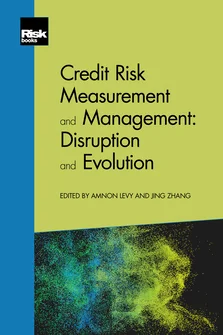Introduction
Amnon Levy and Jing Zhang
Introduction
Foreword
Introduction
An Exploration of the Evolution of Risk: Past, Present and Future
Risk Trading, Risky Debt and Financial Stability
Skating on Thinner Ice: A Macroeconomic Outlook at the End of the Credit Cycle
Climate Change: Managing a New Financial Risk
The Quest to Save Risk-Weighted Assets
The Evolution of the CLO Market since the Global Financial Crisis and a Valuation Approach for CLO Tranches
Homo Ex Machina: Finance Rebooted
Innovation and Digitisation in Credit: A Global Perspective
The Lending Revolution: How Digital Credit Is Changing Banks from the Inside
Digital Lending in Asia: Disruption and Continuity
Digitisation and Automation in Commercial Lending: Disruption without Distraction
Credit Risk Management in the Era of Big Data: From Measurement to Insight
Artificial Intelligence and Machine Learning in Credit Risk Analytics: Present, Past and Future
Integrated Loan Portfolio Modelling and Risk Management
The Role of Banks in Illiquid Credit Markets, and the Disruption and Evolution of Credit Portfolio Management
Epilogue
Credit risk management has changed a great deal since the 1980s, but we are now experiencing profound, rapid evolution in diverse, risk-related areas, at an unrivalled pace. This affects players globally in complex ways, changing how businesses must operate and how they should adapt their risk practices. These changes are one of the most important and timely topics facing credit risk management; they are one area where financial institutions worldwide will spend significant resources in the coming years.
A number of disruptive forces are driving this change. The first relates to rapidly changing technologies, particularly the use of information technology (IT) to increase efficiency. The IT revolution has enabled us to collect and store huge amounts of data for financial risk measurement and management. Advances in machine learning (ML) and artificial intelligence (AI) techniques have allowed data analysis and use in an increasing number of applications. The second force for change, oversight through prudential regulation (eg, Basel III and IV) and reporting standards (International Financial Reporting Standard 9 (IFRS 9) and Current Expected Credit Loss (CECL)), is forcing
Copyright Infopro Digital Limited. All rights reserved.
As outlined in our terms and conditions, https://www.infopro-digital.com/terms-and-conditions/subscriptions/ (point 2.4), printing is limited to a single copy.
If you would like to purchase additional rights please email info@risk.net
Copyright Infopro Digital Limited. All rights reserved.
You may share this content using our article tools. As outlined in our terms and conditions, https://www.infopro-digital.com/terms-and-conditions/subscriptions/ (clause 2.4), an Authorised User may only make one copy of the materials for their own personal use. You must also comply with the restrictions in clause 2.5.
If you would like to purchase additional rights please email info@risk.net











